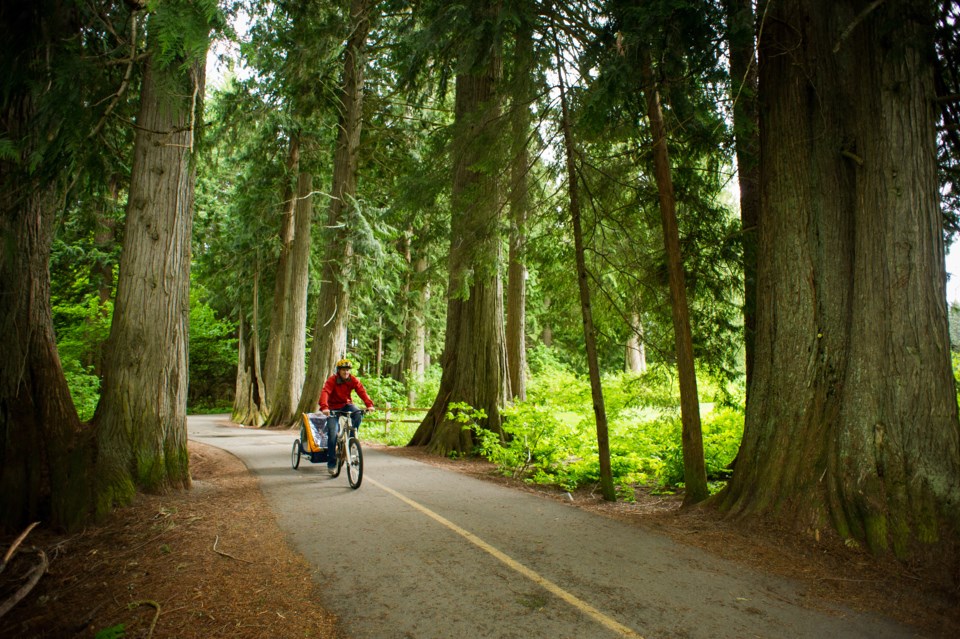The Resort Municipality of Whistler's (RMOW) mayor and council has formally endorsed a new Active Transportation Strategy, which will act as a high-level document to guide efforts to reduce greenhouse gas emissions.
“Passenger vehicles are our largest source of emissions in Whistler, [representing] over 50 per cent of our community-wide emissions,” said Luisa Burhenne, the RMOW’s manager of climate and environment, in a presentation at the July 23 council meeting.
Burhenne, presenting on behalf of the RMOW staff working group that created the strategy, said “getting people out of their cars is the single biggest action we can do to achieve our climate targets,” hence the development of a strategy to lean into other modes of transport.
The Active Transportation Strategy, as explained by Burhenne, was crafted to help identify priority areas, and map out actions that could help Whistler achieve its goal of reducing greenhouse gas emissions by promoting active transportation, which is defined as human-powered transportation.
What it isn't is a list of items to do tomorrow—that comes later.
“The strategy helps us identify where we want to dig deeper, or where we want to go further," Burhenne said. "It is not a plan that outlines specific gaps in our network, and it's not an action that has a timeline and scope and budget. From the strategy we will develop plans.”
The strategy incorporated feedback that suggested the RMOW needed to lean into collecting robust data, invest in active transportation infrastructure, and make active transportation “the most convenient way of getting around.”
Burhenne laid out the strategy's five objectives in her presentation at the July 23 meeting.
First, the strategy seeks to establish a comprehensive, year-round active transportation network that would include cycling along Highway 99 as a commuter route. This would be done through active engagement with the Ministry of Transportation and Infrastructure (MOTI), which has jurisdiction over the highway.
Second, the RMOW needs to create a network that is accessible for everyone, which minimizes conflict between all users: This could be partly achieved by integrating accessibility guidelines into all design decisions around active transportation.
For the third objective, the RMOW needs to invest in essential infrastructure amenities and operational support for the network, such as secure bike parking, lighting and more to make biking around more convenient.
The fourth objective aims to create awareness and increase motivation to use the network, which could be done through programs such as GoByBike week, and the promotion of the e-bike share program in Whistler.
Finally, the fifth objective is to ensure the strategy remains a living document by preparing the network for increasing use through to 2030 and beyond as a result of municipal greenhouse gas goals. Burhenne said by making the strategy flexible and open to new technologies and approaches as they became available, the active transportation network could be future-proof beyond 2030.
Burhenne said the strategy has six measures of success: The transportation mode share (determined through data collection); the rate of infrastructure development; funding efforts to pursue the strategy’s objectives; equity and access of the network; perceived safety of active transportation in the network; and finally the hard number: Greenhouse gas emissions from passenger vehicles in Whistler.
Currently, there are a number of items already underway in Whistler that feed into the active transportation strategy, such as the bike lane demonstration project on Village Gate Boulevard, the ongoing roll-out of more secure bike parking, e-bikes in the bike share program and the bike valet service expansion.
While the strategy is high-level, Burhenne said next steps involve resource planning, and “foundational tasks” to achieve the objectives, such as further MOTI engagement and baking-in design principles.
In comments about the strategy, Mayor Jack Crompton—who served on the working group—acknowledged it was a big ask to take Whistler to a major modal shift in transportation, and it would come with a big price tag.
“The conversations were about significant infrastructure change to prioritize walking and cycling, leveraging emerging technologies in ways that we may not immediately consider, measuring and reporting on our success or not,” he said of the working group.
“I think to me that all came down to a request that we do things very differently than we have done them, and that will have budget impacts, and so as I said, when we consider the community climate action plan, I hope and expect to see some of that aspiration show up in what we consider during our budget season this year, next, and moving forward.
“I’m pleased we did this, and I leave that process with a very clear sense that we want to do things differently, and we’re going to have to pay for it, and we’re going to have to look for ways in having others join us in paying for it, because it won't be cheap.”




